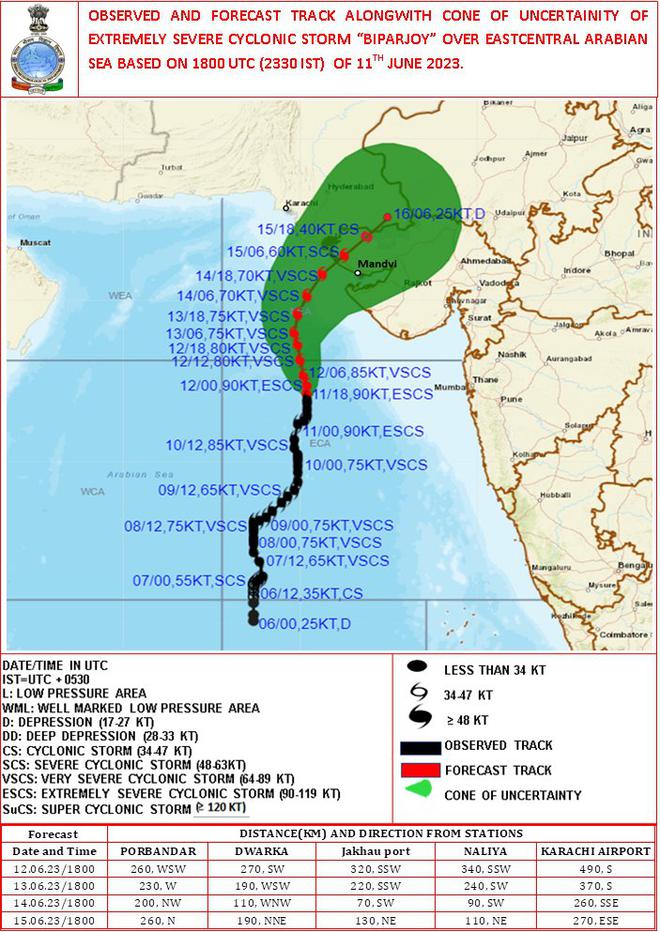Cyclone Biparjoy is still alive and will continue its trek northeastward, bringing some welcome rain to regions sweltering in the summer heat.
By all accounts, the forecasts have been serving the disaster management preparations extremely well. The early warnings, evacuations of tens of thousands in the path of the storm, and the operations during and after the cyclone’s landfall have been improved to a world-class-level in recent years.
A good job
The super-cyclone of 1999 caused nearly 10,000 deaths. The India Meteorological Department (IMD) received scathing criticism for not accurately forecasting that super-cyclone. Now, the reported number of deaths due to Biparjoy has just been two so far. India has successfully planned and executed integrated forecast systems and computational infrastructure to reduce cyclone mortality by nearly 90% from the first decade of the 21st century into the second decade.
The Nobel laureate Niels Bohr reportedly said that forecasting is really difficult, especially if it’s about the future. For complex and nonlinear systems like cyclones and the monsoons, our forecasts will never be perfect.
Then again, our forecasting skills must be measured not just by the errors in the forecast models we build and use but also by tracking how well they serve our disaster management and rescue-and-recovery enterprises. By this measure, India’s cyclone forecasts score quite high. India deserves the kudos it has received from across the world for its cyclone forecasts and cyclone disaster management thus far.
But there is no time to rest on these laurels. Forecasts must continue to improve and, in particular, maximise the quantitative skills of the forecasts of cyclone intensities, lifespans, speeds, and tracks. (‘Skill’ is a term for how accurate the forecasts are.)
Reducing uncertainty
Cyclones are guided in their tracks from above by the so-called steering winds while they feed on the energy provided by the warm upper-oceans. As such, a cyclone is a thermodynamic engine that runs on moving heat from the warm ocean energy into the cold upper atmosphere while producing deadly winds and rain. This is what an IMD-forecast cyclone track looks like:

The green cone surrounding the track is the cone of uncertainty. That is, the cyclone’s path (marked by small red spirals) is most likely to remain within this cone. Note that the cone becomes wider the further ahead we move from the cyclone’s current location, corresponding to longer lead-times of forecasts.
Such cyclone-track uncertainties arise from errors in our forecasts of steering winds. On the other hand, the forecast errors in intensity, duration, and the speed of the cyclone are the result of errors in our forecasts of oceanic conditions.
These shortcomings in the forecasts arise in turn as a result of many factors, including (but not limited to) a lack of sufficient data for initialising forecast models and deficiencies in various processes represented by the models. To quote from a previous article by this author, ‘initialising’ a model means “to have the best estimates of temperature, humidity, winds, and so on at each point of the computer model, using data from ocean moorings, weather balloons, satellites, radiosondes, and such.”
We need to minimise these errors.
IMD has the unenviable job of being fully exposed to media reports on the forecasts – more than a few of them being potentially wrong – even as a cyclone barrels over the ocean towards the coast. It is obligated to issue forecasts to help with disaster management operations to save lives and property. Indeed, the IMD runs multiple forecast models day and night to obtain cyclone forecasts that are better overall. The results are clearly improving each year even as some shortcomings remain.
Academic participation
Whose responsibility is it to improve the forecasts continuously, even as cyclones are managed successfully, with minimum loss of life and property? Improving the computer models in particular, which actually forecast cyclones, isn’t just the responsibility of the IMD, because the department literally works in shifts to issue forecasts.
Citizen participation can lend a hand: we must heed the warnings, follow evacuation orders, avoid visiting places where the risk is high, etc., to ensure the overall success of disaster-management operations.
Another community can play an equally crucial part: India’s academic climate community. This community can build teams to work with the IMD to advance the understanding of cyclone processes and to improve cyclone predictions. India has had a small community of climate scientists for many decades but it has focused its research largely on monsoon processes and predictions.
In the last three decades, strategies were developed to upgrade computational facilities and expand the education and training of the workforce required to develop and implement integrated forecast systems. Today, there are a large number of climate science departments and centres at many of the academic institutions. The incentives for and measures of success in this ecosystem are currently not coupled to the national weather-forecasting enterprise, but they should be.
In particular, the country’s climate research community can identify specific problems in climate variability, change, and trends that affect India’s food, water, energy, health, and infrastructure security, and its economic growth. Individual, curiosity-driven research can go on in parallel, but the country also needs to incentivise a sufficient number of researchers to build teams to help the IMD improve its forecasts.
Performance metrics in academia must consider the value of contributions made by researchers in bringing their science to serve society. Such translation of science can not only improve cyclone forecasts but also forecasts at all scales for managing the safe and sustained trajectory of India’s dreams.
Raghu Murtugudde is a visiting professor at IIT Bombay and an emeritus professor at the University of Maryland.







